Products
PSAP antibody
Category:
Research Area:
- SPECIFICATIONS
- Product Name
- PSAP antibody
- Catalogue No.
- FNab06841
- Size
- 100μg
- Form
- liquid
- Purification
- Immunogen affinity purified
- Purity
- ≥95% as determined by SDS-PAGE
- Clonality
- polyclonal
- Isotype
- IgG
- Storage
- PBS with 0.02% sodium azide and 50% glycerol pH 7.3, -20℃ for 12 months(Avoid repeated freeze / thaw cycles.)
Immunogen
- Immunogen
- prosaposin
- Alternative Names
- GLBA antibody, SAP1 antibody
- UniProt ID
- P07602
- Observed MW
- 60 kDa
Application
- Tested Applications
- ELISA, IHC, WB, IF
- Recommended dilution
- WB: 1:500 - 1:1000; IHC: 1:50 - 1:200; IF: 1:50 - 1:200
Validated Images
 HepG2 cells were subjected to SDS PAGE followed by western blot with FNab06841(PSAP Antibody) at dilution of 1:600
HepG2 cells were subjected to SDS PAGE followed by western blot with FNab06841(PSAP Antibody) at dilution of 1:600
 Immunohistochemistry of paraffin-embedded human prostate cancer using FNab06841(PSAP antibody) at dilution of 1:50
Immunohistochemistry of paraffin-embedded human prostate cancer using FNab06841(PSAP antibody) at dilution of 1:50
 Immunofluorescent analysis of fixed PC-3 cells using 1 FNab06841 (PSAP antibody) at dilution of 1:50 and Alexa Fluor 488-conjugated Goat Anti-Rabbit IgG(H+L)
Immunofluorescent analysis of fixed PC-3 cells using 1 FNab06841 (PSAP antibody) at dilution of 1:50 and Alexa Fluor 488-conjugated Goat Anti-Rabbit IgG(H+L)
- Background
- Saposin-A and saposin-C stimulate the hydrolysis of glucosylceramide by beta-glucosylceramidase(EC 3.2.1.45) and galactosylceramide by beta-galactosylceramidase(EC 3.2.1.46). Saposin-C apparently acts by combining with the enzyme and acidic lipid to form an activated complex, rather than by solubilizing the substrate.Saposin-B stimulates the hydrolysis of galacto-cerebroside sulfate by arylsulfatase A(EC 3.1.6.8), GM1 gangliosides by beta-galactosidase(EC 3.2.1.23) and globotriaosylceramide by alpha-galactosidase A(EC 3.2.1.22). Saposin-B forms a solubilizing complex with the substrates of the sphingolipid hydrolases. Saposin-D is a specific sphingomyelin phosphodiesterase activator(EC 3.1.4.12). Prosaposin: Behaves as a myelinotrophic and neurotrophic factor, these effects are mediated by its G-protein-coupled receptors, GPR37 and GPR37L1, undergoing ligand-mediated internalization followed by ERK phosphorylation signaling. Saposins are specific low-molecular mass non-enzymic proteins, they participate in the lysosomal degradation of sphingolipids, which takes place by the sequential action of specific hydrolases.



